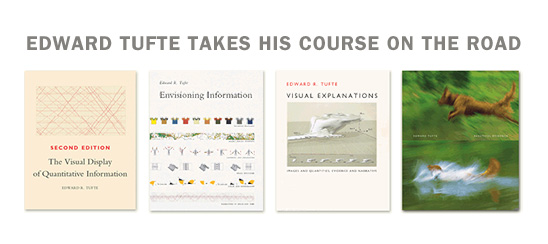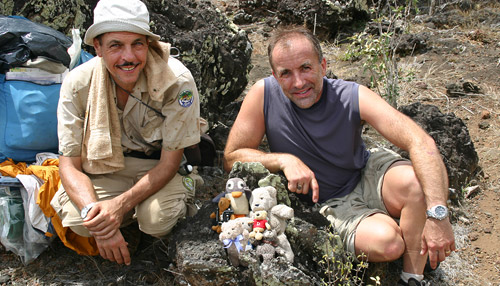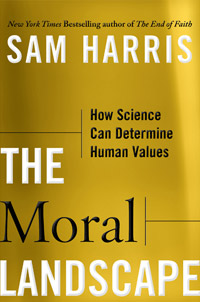In this week’s eSkeptic:
- upcoming course: Edward Tufte Takes His Course on the Road
- new at skeptic.com: American Apparel Clothing for Adults & Kids!
- lectures: How Old is the Universe? and The Shape of Inner Space
- mystery photo: Last week’s photo revealed; plus a new photo
- feature article: Review of Sam Harris’ new book The Moral Landscape
- follow Michael Shermer: The Celebrity of Science Comes to Caltech
Edward Tufte Takes His Course on the Road
WE WANT TO ALERT EVERYONE that one of the most remarkable courses ever devised on data and information, taught by the man the New York Times called “The Leonardo da Vinci of data,” Edward Tufte, who is taking his one-day course on the road to cities around the United States, including:
- San Diego, CA (February 7, 2011)
- Los Angeles, CA (February 8 & 9, 2011)
- Phoenix, AZ (February 11, 2011)
- Boston, MA (February 28, March 1 & 2, 2011)
- Dallas, TX (April 4, 2011)
- Austin, TX (April 6, 2011)
- Houston, TX (April 8, 2011)
- Arlington, VA (May 16, 17, 18, 2011)
Topics covered in this one-day course
- fundamental strategies of analytical design
- evaluating evidence used in presentations
- statistical data: tables, graphics, and semi-graphics
- business, scientific, research, and financial presentations
- complexity and clarity
- effective presentations: on paper and in person
- interface design
- use of PowerPoint, video, overheads, and handouts
- multi-media, internet, and websites
- credibility of presentations
- animation and scientific visualizations
- many practical examples
The fee for the one-day course is $380 per person. This fee includes all four books, Visual Explanations, Envisioning Information, The Visual Display of Quantitative Information, and Beautiful Evidence. Groups of 10 or more, registering simultaneously, receive a 20% discount. The fee for full-time students not currently employed is $200; fax or mail a copy of your current student ID, phone number of school registrar who can verify your student status, and our course registration form. There are no other discounts.
To register, call 1-800-822-2454 or 1-203-250-7007 or
Check out our new line of clothing at skeptic.com
Now available at Skeptic.com: Check out our new line of Skeptic T-shirts and Hoodies by American Apparel, known for quality construction and luxurious fabric. Featuring a trendy new design by Daniel Loxton. These are the same shirts that were a sell-out hit at TAM8 last year. Six different styles for men, women and children.
Next Lectures at Caltech
A Special Dual Event
How Old is the Universe? and
The Shape of Inner Space
with Dr. David Weintraub
and Dr. Shing-Tung Yau
Sunday, February 13, 2011 at 2 pm
Baxter Lecture Hall
How Old is the Universe?
IT’S ALL VERY WELL FOR ASTRONOMERS to say that the universe is 13.7 billion years old, but how do they know? Vanderbilt University astronomer David Weintraub explains it all for astronomy buffs in an enthusiastic way. He starts with how scientists first determined the age of the solar system — about 4.5 billion years — by isotope dating the oldest known rocks: lunar rocks brought back by astronauts, and meteorites that have collided with Earth. He then shows how stellar life cycles indicate an age of about 13 billion years. Refining that number requires measuring things we can’t even see, such as dark energy and dark matter. Weintraub explains various dating approaches and illustrates the work of astronomers to find the answer to one of the most basic questions about our universe. Order the book on which this lecture is based from Amazon.com.
The Shape of Inner Space: String Theory and the Geometry of the
Universe’s Hidden Dimensions
String theory describes one of the smallest things you can possibly imagine — six-dimensional geometric spaces that may be more than a trillion times smaller than an electron — that could be one of the defining features of our universe. Dr. Yau tells the story of those spaces, which physicists have dubbed “Calabi-Yau manifolds,” and how Dr. Yau managed to prove the existence, mathematically, of those spaces, despite the fact that he had originally set out to prove that such spaces could not possibly exist. Order the book on which this lecture is based from Amazon.com.
Ticket information
Tickets are first come first served at the door. Seating is limited. $8 for Skeptics Society members and the JPL/Caltech community, $10 for nonmembers. Your admission fee is a donation that pays for our lecture expenses.

Last Week’s Mystery Photo is of Stephen Jay Gould at Harvard University’s fossil collection. For this week’s Mystery Photo (below), identify the man on the left, the location of the photo, and what we are doing with all those stuffed bears (and one penguin)?
About this week’s feature article
In this week’s eSkeptic Massimo Pigliucci reviews Sam Harris’ latest book The Moral Landscape: How Science Can Determine Human Values. Because it is somewhat critical of Harris’s thesis that science can determine human values, you may wish to also read Michael Shermer’s more positive column in Scientific American on the subject (which he too has written extensively about in his own book, The Science of Good and Evil). Finally, read Harris’ extended response to critics in the Huffington Post.
Massimo Pigliucci is a philosopher at the City University of New York-Lehman College in New York and a regular columnist for Skeptical Inquirer and Philosophy Now. His books include: Nonsense on Stilts: How to Tell Science from Bunk and Evolution — the Extended Synthesis.
Science and the Is/Ought Problem
by Massimo Pigliucci
In 1739 the great Scottish philosopher and skeptic David Hume outlined in his Treatise of Human Nature the problem of mixing the way something is with the way something ought to be:
In every system of morality, which I have hitherto met with, I have always remark’d, that the author proceeds for some time in the ordinary ways of reasoning, and establishes the being of a God, or makes observations concerning human affairs; when all of a sudden I am surpriz’d to find, that instead of the usual copulations of propositions, is, and is not, I meet with no proposition that is not connected with an ought, or an ought not. This change is imperceptible; but is however, of the last consequence. For as this ought, or ought not, expresses some new relation or affirmation, ‘tis necessary that it shou’d be observ’d and explain’d; and at the same time that a reason should be given; for what seems altogether inconceivable, how this new relation can be a deduction from others, which are entirely different from it.
What Sam Harris wishes to do in his new book, The Moral Landscape: How Science Can Determine Human Values, is to mount a science-based challenge to Hume’s famous separation of facts from values. For Harris, values are facts, and as such they are amenable to scientific inquiry. I think he is spectacularly wrong.
Let me first begin by making clear that there is much about which Harris and I agree. We are both moral realists, i.e. we believe that moral questions do have non-arbitrary answers, though our realism is, as will be clear in a moment, of a very different nature. We both agree that religion has absolutely nothing to do with morality, though I don’t think of it as “the root of all evil” either, to use Richard Dawkins’ phrase, which Harris seems to endorse with glee throughout this (and his previous) book. Lastly, as an obvious corollary of our moral realism, both Harris and I think that moral relativism is a silly notion, and that it is in fact downright pernicious in its effects on individuals and society.
Here is where the two of us disagree: I do not think that science amounts to the sum total of rational inquiry (a position often referred to as scientism), which he seems to assume. I do think that science should inform the specifics of our ethical discussions, and hence is in an important sense pertinent to ethics, but I maintain that ethical questions are inherently philosophical in nature, not scientific. Ignoring this distinction, I think, does a disservice to both science and philosophy. Finally, as a corollary of my rejection of scientism above, I do think that there are significant differences between science and philosophy, even though of course the demarcation line between the two is far from being sharp. Indeed, I think that a combination of these two disciplines — which used to be called “scientia” (knowledge in the broadest possible sense) — is our best hope for a more rational and compassionate humanity.
Before I get to the meat, let me point out that I think Harris undermines his own project in two endnotes tucked in at the back of his book. In the second note to the Introduction, he acknowledges that he “do[es] not intend to make a hard distinction between ‘science’ and other intellectual contexts in which we discuss ‘facts.’” But wait a minute! If that is the case, if we can define “science” as any type of rational-empirical inquiry into “facts” (the scare quotes are his) then we are talking about something that is not at all what most readers are likely to understand when they pick up a book with a subtitle that says “How Science Can Determine Human Values” (my italics). One can reasonably smell a bait and switch here. Second, in the first footnote to chapter 1, Harris says: “Many of my critics fault me for not engaging more directly with the academic literature on moral philosophy … I am convinced that every appearance of terms like ‘metaethics,’ ‘deontology,’ … directly increases the amount of boredom in the universe.” That’s it? The whole of the only field other than religion that has ever dealt with ethics is dismissed because Sam Harris finds it boring? Is that a fact or a value judgment, I wonder?
Harris wants to deliver moral decision making to science because he wants to defeat the evil (if oddly paired) twins of religious fanaticism and moral relativism. Despite the fact that I think he grossly overestimates the pervasiveness of the latter, we are together on this. Except of course that the best arguments against both positions are philosophical, not scientific. The most convincing reason why gods cannot possibly have anything to do with morality was presented 24 centuries ago by Plato, in his Euthyphro dialogue (which goes, predictably, entirely unmentioned in The Moral Landscape). In this dialogue, Plato’s favorite protagonist Socrates asks a young man named Euthyphro the following question: “The point which I should first wish to understand is whether the pious or holy is beloved by the gods because it is holy, or holy because it is beloved of the gods?” That is, does God embrace moral principles naturally occurring and external to Him because they are sound (“holy”) or are these moral principles sound because He created them. It cannot be both.
Moral relativism too has been the focus of sustained and devastating attack in philosophy, for instance by thinkers such as Peter Singer and Simon Blackburn, and this is thanks to the large metaethical literature that Harris finds so increases the degree of boredom in the universe.
Harris’ chief claim throughout the book is that moral judgments are a kind of fact, and that as such they are amenable to scientific inquiry. First of all, the second statement does not at all follow from the first. Surely we can agree that the properties of triangles in Euclidean geometry are “facts,” in the sense that nobody who understands Euclidean geometry can opine that the sum of the angles in a triangle is not 180° and get away with it. But we do not use science, or any kind of empirical evidence at all, to arrive at agreement about such facts. Morality, of course, is not mathematics, but it is easy to show that science only informs, doesn’t determine, our ethical choices. Consider abortion. If we agree, for the sake of argument, that abortion is morally permissible before the fetus can feel any pain, then it is a matter for science to give us the best empirical estimate of when approximately that happens during human development. But notice that science cannot make us agree on whether that particular criterion (pain) is moral or not. We need to argue for it in some other way.
How? A friend of mine — who incidentally is usually very skeptical of philosophical arguments — has recently told me of a conversation she often has about vegetarianism, a conversation that is both a perfect example of applied ethical philosophy and a good illustration of why Harris is off the mark with his project. When one of her acquaintances questions the moral grounds of her vegetarian commitment, she replies by asking whether that person endorses bestiality. Taken aback, the interlocutor’s first reaction often invokes some sort of “yuck factor,” only to realize that this would be emotivism (one of the words that Harris thinks is incredibly boring), i.e., it doesn’t amount to a rational reason. The second line of defense, typically, is something like “bestiality forces the animal to comply with an action it has not given consent to.” My friend then smiles, smelling the philosophical kill now at hand. “But surely you will agree that eating an animal is also an action that we are forcing upon it without consent!” QED, the opponent has been forced — by the strength of the logical argument — to admit to a serious inconsistency in his thinking. Now he has a limited number of options available: become a vegetarian, grudgingly agree that bestiality is morally defensible, or look for another argument that distinguishes bestiality from meat eating. Notice that in all of this, no science of human emotions or animal husbandry was required, besides a basic knowledge of what kinds of things animals are.
Harris, I suspect, would not be content with this. He wants science — and particularly neuroscience (which just happens to be his own specialty) — to help us out of our moral quandaries. But the reader will wait in vain throughout the book to find a single example of new moral insights that science provides us. Harris tells us that genital mutilation of young girls is wrong. I agree, but certainly we have no need of fMRI scans to tell us why: the fact that certain regions of the brain are involved in pain and suffering, and that we might be able to measure exactly the degree of those emotions doesn’t add anything at all to the conclusion that genital mutilation is wrong because it violates an individual’s right to physical integrity and to avoid pain unless absolutely necessary (e.g., during a surgical operation to save her life, if no anesthetic is available).
Indeed, Harris’ insistence on neurobiology becomes at times positively creepy, as in the section where he seems to relish the prospect of a neuro-scanning technology that will be able to tell us if anyone is lying, opening the prospect of a world where government (and corporations) will be able to enforce no-lie zones upon us. He writes: “Thereafter, civilized men and women might share a common presumption: that whenever important conversations are held, the truthfulness of all participants will be monitored. … Many of us might no more feel deprived of the freedom to lie during a job interview or at a press conference than we currently feel deprived of the freedom to remove our pants in the supermarket.” If these sentences do not conjure the specter of a really, really scary Big Brother in your mind, I suggest you get your own brain scanned for signs of sociopathology (or watch a good episode of Babylon 5).
At several points in the book Harris seems to think that neurobiology will be so important for ethics that we will be able to tell whether people are happy by scanning them and make sure their pleasure centers are activated. He goes so far as telling us that scientific research shows that we are wrong about what makes us happy, and that it is conceivable that “evil” (quite a loaded term, for a book that shies away from philosophy) might turn out to be one of many paths to happiness — meaning the stimulation of certain neural pathways in our brains. Besides the obvious point that if what we want to do is stimulate our brains so that we feel perennially happy, all we need are appropriate drugs to be injected into our veins while we sit in a pod in perfectly imbecilic contentment, these are all excellent observations that show that science cannot answer moral questions. As Harris points out, for instance, research shows that people become less happy when they have children. What does this fact about human behavior have to do with ethical decisions concerning whether and when to have children?
Moreover, Harris entirely evades philosophical criticism of his positions, on the simple ground that he finds metaethics “boring.” But he is a self-professed consequentialist — a philosophical stance close to utilitarianism — who simply ducks any discussion of the implicatons of that a priori choice, which informs his entire view of what counts for morality, happiness, well-being and so forth. He seems unaware of (or doesn’t care about) the serious philosophical objections that have been raised against consequentialism, and even less so of the various counter-moves in logical space (some more convincing than others) that consequentialists have made to defend their position. This ignorance is not bliss, and it is the high price the reader pays for the crucial evasive maneuvers that Harris sneaks into the footnotes I mentioned at the beginning.
Skeptical perspectives on science, morality and religion…
-
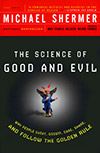 The Science of Good & Evil
The Science of Good & Evil
by Michael Shermer (paperback $17)
-
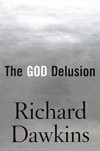 The God Delusion
The God Delusion
by Richard Dawkins (paperback $15.95)
-
 Living Without Religion
Living Without Religion
by Paul Kurtz (paperback $14)

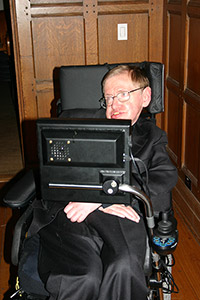
NEW ON SKEPTICBLOG.ORG
The Celebrity of Science
Comes to Caltech
On Tuesday, January 18, 2011, physicist, cosmologist, writer, and science celebrity Stephen Hawking spoke in Caltech’s Beckman Auditorium on the subject of “My Brief History,” an autobiographical journey through the life of one of the most famous scientists in history. Tickets were in such high demand that I had to go as a member of the press, writing for Scientific American, Skeptic, eSkeptic, and Skeptic.com, and even then it wasn’t clear I was getting in to actually hear the lecture…


